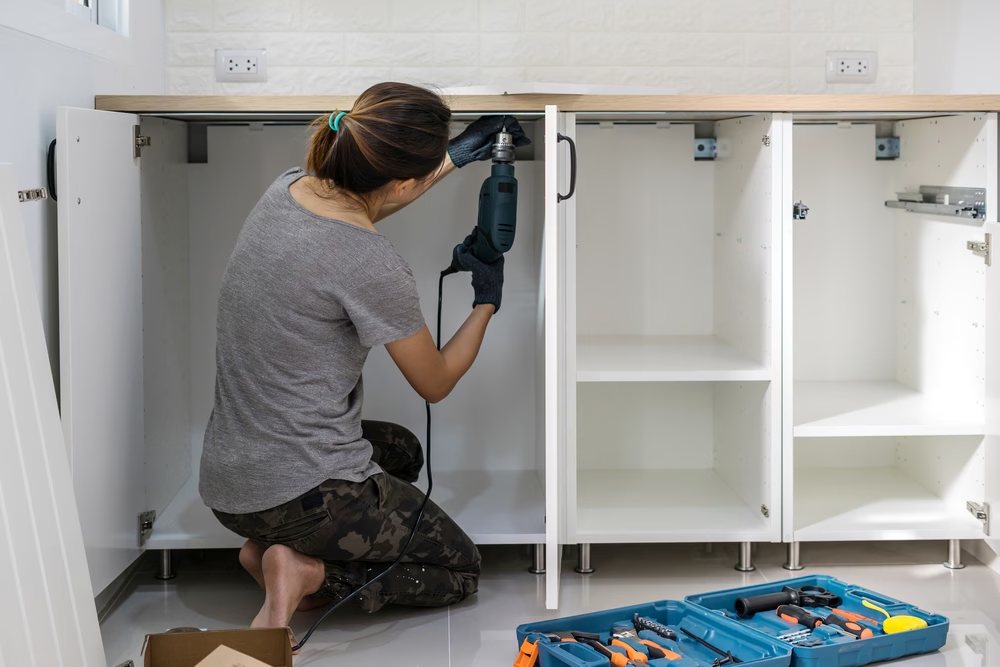Upgrading your kitchen can be expensive, but it doesn’t have to break the bank. When you decide to build your own kitchen cabinets, you end up saving a lot of money, and you also get to make them to your specifications, according to your kitchen’s needs. This task may be time-consuming, but it will be worth it in the end. If you are wondering how to do it, it is obtainable and achievable. All you need is to have the proper tools, materials, and techniques to do so, and you are all set to go.
In this guide, we will help you every step of the way when it comes to constructing a kitchen cabinet. We will discuss all the steps involved in building a kitchen cabinet, including measuring, assembling, cutting, and finishing. If you need a kitchen renovation, custom cabinets are the way to go. Kitchen remodeling experts can guide the entire process. So what are you waiting for? Let’s go!
1. Kitchen Cabinet Design Planning
This is the first stepping stone toward building your very own kitchen cabinets, and ultimately, the most crucial part of the entire project. Planning your design will guide every detail, from materials to the cabinetry construction approach to the final construction.
You’ll need to jot down the dimensions of your kitchen layout and available space. Get the height, width, and depth of the areas where you want cabinets. Also, measure the available cabinetry space where all plumbing, electrical, and cabinetry appliances reside. After measuring, it’s a good idea to draw a layout of your kitchen and plan storage for pots, pans, spices, and dishes. For design planning, you can check out cabinet design software.
2. Choose Your Supplies
Choosing which cabinets are the most long-lasting and visually appealing. Plywood or melamine for the cabinet boxes. It’s inexpensive and will last a long time. The doors and the fronts are best constructed and finished in oak, maple, or cherry.
If you will have painted cabinets, then MDF (Medium Density Fiberboard) is the best choice, for it is smooth and seamless. For a more economical project, the Particleboard can work, but it will not do well in wet areas. After your wood is selected, the rest is hardware (hinges, handles, knobs) that fit your design.
3. Get Your Equipment
Making kitchen cabinets will require an assortment of equipment. For this project, the essentials include:
- Saw (circular or table): This is used to cut your wood to the desired sizes.
- Power Drill: Drilling, replacing, and screwing.
- Measuring Tape: Get accurate dimensions.
- Wood Glue: Secure and close the joints.
- Sanding Tools: Smooth the sharp edges.
Having the correct equipment will simplify the task and enable you to finalize your work professionally. Don’t forget to put on your safety gloves and goggles to ensure your protection.
4. Construct the Cabinet Boxes
This is the most enjoyable step. Begin by cutting your plywood into pieces for the cabinet’s sides, top, bottom, and back. Take your time measuring and cutting to ensure your pieces fit together. After cutting, construct the cabinet by joining the top, bottom, and side panels together with wood glue and screws. After the cabinet is up, you may also want to add wood glue to the corners for extra support.
If you want to customize the spacing for your shelves, you may add shelf pins and brackets. Take time to square the cabinet frame and to prep the cabinet for the next steps.
5. Make and Attach the Doors
Now that the cabinet box is complete, it is time to construct the doors. No matter if you are building shaker-style, flat-panel, or raised-panel doors, careful measuring and cutting of the door pieces is important. When using hardwood for doors, make the frame first, then insert the center panel. For the best result, all joints should be tight and the door should be level..
After the doors are constructed, you can install the hinges and check the door fit. Adjust the doors until they open and close correctly and smoothly. If the doors still stick, try sanding down the edges.
6. Sand and Finish
Sanding is one of the most important steps in building kitchen cabinets. First, use coarse sandpaper to erase rough edges and to cut down imperfections. Then switch to finer sandpaper to achieve a smooth, polished surface. This is the most important step to achieve a professional, factory-like finish.
To achieve even painterly effects on cabinets, use primer first. When staining, an ultimate enhancement to the wood’s real beauty is the finish. For protection with a gloss luster, use lacquer or polyurethane. For a subdued or unglossed finish, oils and waxes are also great options.
7. Mount the Cabinets
It is now time to install the cabinets once the finish is completely dry. Using a stud finder, locate the studs on the wall and mark them to ensure the cabinets won’t sag. You can install the upper cabinets first, as they are less obstructed. Use heavy-duty screws to fasten the cabinets, while ensuring they are straight.
With the upper cabinets secured, install the base cabinets. To create a seamless structure, interconnect the cabinets and fill any gaps with a filler strip to cover any spaces between the cabinets and the wall.
8. Final Touches
For the last part, add your chosen cabinet accessories. These can include drawers, organizers, glass fronts, and other structures for a designed makeover, as well as for additional storage.
For an added touch, you can install under-cabinet lighting on your new kitchen cabinets. Simple touches like this can transform your kitchen into a warm, inviting space.
Benefits of Building Your Own Kitchen Cabinets
There are many advantages to building your own kitchen cabinets. First is the cost-effectiveness. Using inexpensive materials and cheap DIY labor saves you a lot of money compared to buying custom cabinets. You will also be able to design the cabinets in any way, size, and finish you need and want. This will make sure that the cabinets suit your needs and style.
Lastly, take on your own kitchen projects with the confidence that you will increase your skills and take pride in your work. A little foresight and attention will, of course, transform the space into a work of art that meets your functional needs.
Conclusion
Building your own kitchen cabinets in Commack, NY, or remodelling your kitchen can be both a challenging and incredibly rewarding DIY project. Not only does it allow you to customize your kitchen to fit your exact needs, but it can also save you a significant amount of money. By following this step-by-step guide, you’ll have the knowledge and confidence to create beautiful, functional kitchen cabinets that will last for years to come.
While DIY kitchen cabinet building is a great option for some, remember that there are kitchen remodeling experts available if you need additional guidance or professional help. Whether you decide to tackle the project yourself or get the help of a professional, you can achieve the kitchen of your dreams with the right plan and resources.
FAQs About How to Make Kitchen Cabinets
How long does it take to build your own kitchen cabinets?
Your experience and the design’s complexity will determine how long it takes. Generally, it can take a few days to a few weeks to build your own kitchen cabinets.
What materials work well for DIY kitchen cabinets?
Plywood is great for cabinet boxes, as well as oak, maple, and cherry, ideal hardwoods for doors and fronts. MDF works great if you want smooth painted cabinetry.
Can I build kitchen cabinets without professional experience?
Yes, you can. With proper guides, tools, and a descriptive resource, a beginner can construct DIY kitchen cabinets. Just take your time to understand and build well.
Should I use a cabinet kit or build from scratch?
If you have confidence in your woodworking skills and want full control of the design, then building from scratch is the way to go. But if you want a less time-consuming, easier path, getting cabinet kits is a better option.


